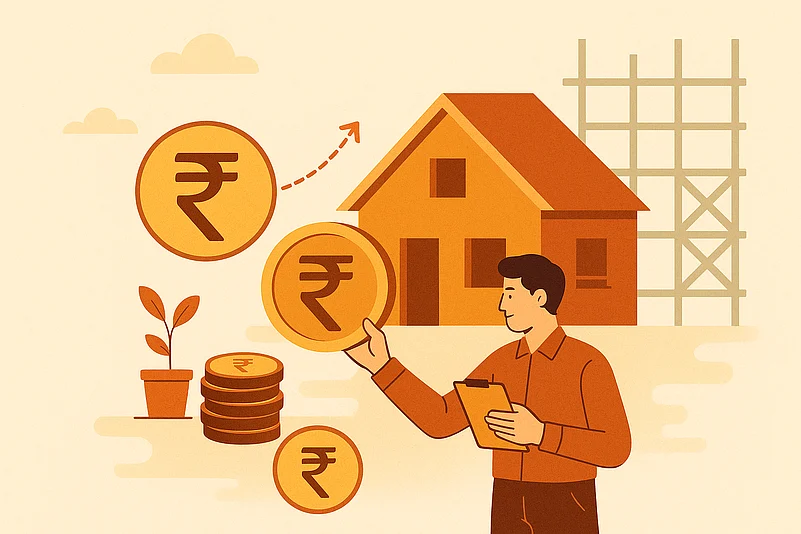For many homebuyers, buying an under-construction property with a home loan is a preferred option. Buying an under-construction property can potentially cost less than purchasing a ready-to-move-in properties. Buying a property that is under-construction can also provide buyers more time to organise their finances. However, there is one expense which usually catches borrowers off guard: the pre-EMI.
What is Pre-EMI
Pre-EMI is the interest you pay on the home loan amount that the builder has already received from the bank. While the standard EMI payment includes repayment for both the loan amount (principal) and interest, a pre-EMI is paid only to repay the interest. Borrowers who purchase under-construction homes begin to pay pre-EMIs immediately after the bank disburses the first tranche of the loan to the builder, and this goes on until the entire loan is disbursed and your regular EMI kicks in.
At times, banks recommend pre-EMI schemes to make the loan look more manageable.
Tax Rules Regarding Pre-EMIs
Additionally Indian tax rules allow you to claim a tax deduction of interest paid on your home loan, including pre-EMI interest, but only if you opt for the old tax regime. In the old tax regime, Section 24 of the Income Tax Act enables you to claim a maximum of Rs 2 lakh annually for interest paid on a self-occupied house. The pre-EMI interest can be claimed in equal installments over five years from the year when the construction is done. But if you opt for the new tax regime, you cannot claim this relief. However, borrowers must be careful and know that the short-term comfort and tax benefit can ultimately result in a greater long-term burden.
When And Why Pre-EMIs Begin
Typically when a loan is borrowed for an under-construction property, the bank never provides the full loan amount upfront. The bank releases the funds in phases depending on the progress of the construction work. For instance, the bank may provide Rs 10 lakh initially, then Rs 15 lakh after the next stage, and so on. The borrower only pays interest on the loan advanced according to the phase of construction the property is in, which is the pre-EMI.
This goes on until the bank disburses the entire loan amount. When the amount is fully disbursed the borrower gets possession of the house (whichever is sooner), and then the borrower begins paying regular EMI.
The Hidden Cost Of Waiting
At first, pre-EMIs seem helpful because they are lower than full EMIs. For example,If you take a Rs 50 lakh home loan at 9 per cent (the current home loan interest in India ranges between 8.45 per cent to 10.75 per cent, depending to the lender, borrower profile, and loan amount) for 20 years, your full EMI would be around Rs 44,986. Suppose the bank disburses only Rs 20 lakh initially and you opt for the pre-EMI route. You’ll pay about Rs 15,000 per month in interest for three years, totalling around Rs 5.4 lakh , without reducing your loan balance. After full disbursal, you begin paying the full EMI for 20 years, pushing your total repayment to around Rs 1.13 crore.
Now, if you choose to start full EMIs from the beginning, and your bank allows it, you begin repaying both principal and interest early, even on the disbursed amount. The EMI may initially be lower than Rs 44,986, depending on the disbursed portion, but you begin reducing the loan from day one. This brings your total repayment closer to Rs 1.08 crore, avoiding the extra Rs 5.4 lakh paid during the pre-EMI period.
Here's a quick comparison on how the two repayment approaches effect your total loan cost:
| Feature | Pre-EMI Option | Full EMI from Day One Option |
| Loan Amount | Rs 50 lakh | Rs 50 lakh |
| Initial Disbursal | Rs 20 lakh | Rs 20 lakh (assumed same for fair comparison) |
| Monthly Outgo (First 3 Years) | ~Rs 15,000 (interest only on Rs 20 lakh) | ~Rs 44,986 (EMI includes principal + interest on disbursed amount) |
| Total Pre-EMI Paid in 3 Years | Rs 5.4 lakh approx | Not applicable |
| EMI After 3 Years | Rs 44,986 for 20 years, on the rest Rs 30 lakh | ~Rs 44,986 (same or slightly adjusted as disbursal increases), on the rest Rs 30 lakh |
| Total Repayment Over Time | ~Rs 1.13 crore (includes pre-EMI) | ~Rs 1.08 crore |
| Principal Reduction During First 3 Years | None | Yes � principal starts reducing from month one |
| Overall Cost | Higher due to delayed principal repayment | Lower due to early principal repayment |
| Who Should Choose | Borrowers are not able to afford full-EMI from the start | Borrowers who can afford EMIs from the start |
So, while pre-EMIs lower your short-term burden, opting for full EMI early reduces your total loan cost over time.
In most cases of mid-range projects, the construction takes 12 to 18 months, according to Rera. That would mean that you'd pay Rs 4–5 lakh in pre-EMIs alone, even before your actual loan repayment starts.
Ask Before You Sign
Pre-EMIs seldom get detailed out at the time of loan sanction. Homebuyers must insist on knowing the interest they will pay prior to possession and if they can opt to begin full EMIs instead.
Knowing how pre-EMIs function, for how long, and their impact on the overall cost of your loan is the key to making an informed borrowing choice, particularly when purchasing an under-construction property.











